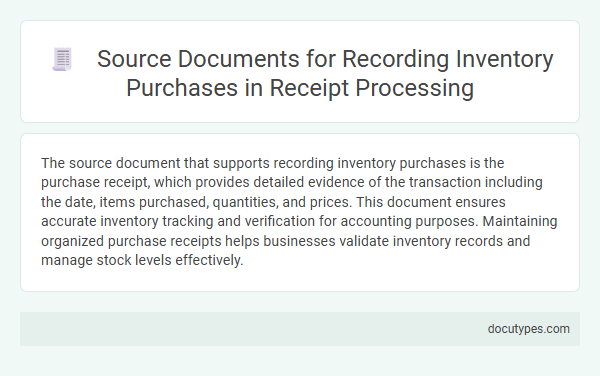The source document that supports recording inventory purchases is the purchase receipt, which provides detailed evidence of the transaction including the date, items purchased, quantities, and prices. This document ensures accurate inventory tracking and verification for accounting purposes. Maintaining organized purchase receipts helps businesses validate inventory records and manage stock levels effectively.
Introduction to Source Documents in Inventory Purchasing
Source documents play a crucial role in accurately recording inventory purchases. A receipt serves as the primary source document that provides detailed evidence of the transaction between the buyer and supplier. This document includes essential information such as the purchase date, quantities, prices, and descriptions of inventory items, ensuring proper inventory management and accounting accuracy.
Importance of Accurate Receipt Processing
The source document that supports recording inventory purchases is the receipt, which provides a detailed record of the transaction. Accurate receipt processing is crucial for maintaining precise inventory levels and ensuring financial integrity.
- Verification of Inventory Quantity - Receipts confirm the exact number of items purchased, preventing discrepancies in stock records.
- Financial Accuracy - Properly processed receipts ensure that purchase costs are correctly recorded, aiding in budget management and cost control.
- Audit Trail Creation - Receipts serve as official documentation for purchasing activities, supporting transparency and accountability in your inventory management system.
Types of Source Documents Used in Inventory Transactions
Source documents are essential for accurately recording inventory purchases in accounting systems. Your inventory transactions rely on these documents to verify quantity, cost, and authorization details.
- Purchase Orders - These documents specify the items ordered, quantities, and agreed prices, serving as formal requests for inventory purchase.
- Receiving Reports - These reports confirm the actual receipt of inventory items and their condition, matching orders with physical deliveries.
- Supplier Invoices - Invoices provide the official billing details from vendors, including price, terms, and payment information necessary for recording purchases.
Key Information Captured on Inventory Receipts
Inventory purchases are recorded using source documents known as inventory receipts. These documents verify the receipt of goods and provide essential details for accurate inventory management.
- Supplier Information - Identifies the vendor from whom the inventory was purchased.
- Item Details - Specifies product descriptions, quantities received, and unit prices.
- Transaction Date - Records the date the inventory was received to track inventory flow.
Accurate recording of inventory receipts ensures proper stock tracking and financial reporting.
Common Formats of Inventory Purchase Receipts
Inventory purchases are supported by source documents known as purchase receipts, which verify and detail each transaction. Common formats of inventory purchase receipts include printed invoices, electronic receipts, and purchase orders with supplier confirmations. Your accurate record-keeping relies on these documents to ensure proper inventory management and financial accuracy.
Best Practices for Managing Source Documents
| Source Document | Description | Best Practices for Managing Source Documents |
|---|---|---|
| Receipt | A receipt serves as a primary source document verifying the purchase of inventory items. It includes details such as the date of purchase, vendor information, item description, quantities purchased, and total cost. |
|
Role of Source Documents in Financial Auditing
What source document supports recording inventory purchases? Source documents such as purchase orders, vendor invoices, and receiving reports provide essential evidence for recording inventory purchases. These documents verify transaction authenticity and ensure accurate financial records.
How do source documents impact the role of financial auditing in inventory management? Auditors rely on source documents to validate inventory transactions and assess internal controls. Accurate source documents help detect discrepancies, prevent fraud, and maintain financial statement integrity.
Integrating Digital Receipts in Inventory Management
Source documents such as digital receipts play a crucial role in supporting the recording of inventory purchases. These receipts provide verifiable transaction details, including item descriptions, quantities, and purchase prices.
Integrating digital receipts into inventory management systems enhances accuracy by automating data entry and reducing human errors. This integration also facilitates real-time tracking and reporting of inventory levels, improving operational efficiency.
Challenges in Receipt Processing for Inventory Purchases
Source documents such as purchase orders and supplier invoices are essential for accurately recording inventory purchases. These documents provide critical information, including item descriptions, quantities, prices, and purchase dates that validate inventory entries.
Challenges in receipt processing for inventory purchases include discrepancies between the ordered items and delivered goods, which can lead to inaccurate inventory records. You must also manage delayed invoices and damaged shipments, both of which complicate timely and precise inventory updates.
What Source Document Supports Recording Inventory Purchases? Infographic

